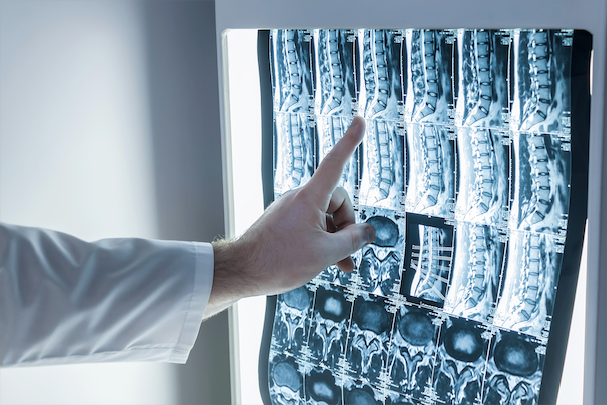But My MRI Says I’ve Got…
Ahhh imaging (X-rays, MRI’s, CT Scans, Ultrasounds, etc.). These tools are some of modern science’s most amazing achievements. I mean, seriously, how cool is it that we can use a machine to peer inside of the human body and see what exists in there without having to get out a scalpel and open that body up?? Countless lives have been saved because of the invention of these imaging techniques, and they are absolutely critical in the management of some of the most dangerous medical conditions.
However, in the world of orthopedics and musculoskeletal medicine (issues with muscles, bones, joints, and nerves), imaging can be both incredibly helpful, and sometimes incredibly harmful. Sound strange? Let me explain…
Let’s use a fictional patient as an example. We’ve got James here, he’s 48-years-old, he’s a lawyer, and he had a flare up in back pain after a long weekend of putting out mulch in his yard. He went to his primary care physician’s office, and they took an X-ray of his lower back. The doctor said “ahh you see right here? There’s not much space between those vertebrae, that means you have degenerative disc disease. That also means your nerves are getting pinched in that area, so that’s why you have this back pain. Keep moving and take this medication to help with the pain, and if it gets worse, we’ll get an MRI and refer you to a spine specialist.” James leaves that appointment with a lot on his mind. “Degenerative disc disease? My discs are degenerating? That sounds terrible! what happens if they degenerate all the way?? Will those pinched nerves not work anymore? Will I be able to walk??” Who could blame James for thinking that way? He’s a lawyer, not a doctor!
Now let’s think that through. “Degenerative discs” don’t happen overnight, it takes years for that to happen. But James felt great before doing all that yardwork! Sure, he had an achy back here and there, but nothing major. Haven’t those degenerative discs been there for a long time before his pain flared up after mulching? It seems pretty likely that those degenerative discs and/or “pinched nerves” may NOT be why he is having pain, or at least they don’t tell the whole story.
Let’s bring in some research here. In 2015, a great study was published where the authors looked at all of the research they could find that investigated imaging (specifically MRI’s and CT Scans) findings of people with NO SYMPTOMS. That’s right, no low back pain, no numbness, no symptoms whatsoever. Here is what the researchers found when they looked at the images of those pain-free peoples’ low backs:
When we look at this table, we see that for a guy like James, who is 48-years-old, it’s almost impossible for him not to have disc degeneration (see the top line in the table, under the age 50). 80% of people WITHOUT PAIN who are his age have disc degeneration. So, is it likely that disc degeneration is the cause of his pain? Probably not, since almost all pain-free individuals have those same findings.
But now that James has heard about the “degenerative disc disease” he can’t help being really worried and losing some hope of a fulfilling and active future. This can spiral easily into James significantly limiting his activities to try to protect his back, giving up things that he loves to do, and seeing his health decline as a result of this inactivity. We know from countless research studies on the topic that this is the exact WRONG thing to do if someone has back pain. But again, James isn’t a doctor, he hasn’t read that research, and who could blame him for coming to those conclusions?
So that’s the issue with imaging- it allows us to see what is inside the body, but it cannot tell us if what we’re seeing has any relevance to symptoms that someone has. This holds true when we look at imaging of other body parts too. Studies have shown that imaging of the shoulder, neck, knee, and hip are often not very helpful in finding the true source of why someone is hurting, except in the cases of major injuries or diseases. Figuring out what’s causing symptoms in the vast majority of cases requires a detailed examination of how someone moves, how their muscles are functioning, how sensitive their nerves are, and how things like stress, sleep, and nutrition may be influencing their body. So please, don’t be scared of imaging results. Don’t base decisions for what you can and cannot do solely on what an X-ray or an MRI shows. There’s always a way to stay active and healthy, and to live a fulfilling life! If you need help with figuring out how, we’d love to help you! Send us an email or schedule an appointment to begin that journey!
Reference:
Brinjikji W, Luetmer PH, Comstock B, Bresnahan BW, Chen LE, Deyo RA, Halabi S, Turner JA, Avins AL, James K, Wald JT, Kallmes DF, Jarvik JG. Systematic literature review of imaging features of spinal degeneration in asymptomatic populations. AJNR Am J Neuroradiol. 2015 Apr;36(4):811-6. doi: 10.3174/ajnr.A4173. Epub 2014 Nov 27. PMID: 25430861; PMCID: PMC4464797.


